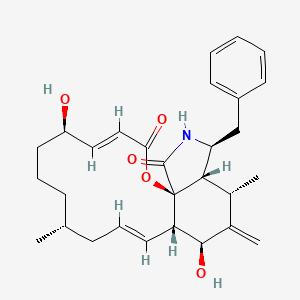| MeSH term | MeSH ID | Detail |
|---|---|---|
| Granulomatous Disease, Chronic | D006105 | 4 associated lipids |
| Leukemia, Erythroblastic, Acute | D004915 | 41 associated lipids |
| Melanoma | D008545 | 69 associated lipids |
| Asthma | D001249 | 52 associated lipids |
| Kidney Diseases | D007674 | 29 associated lipids |
| Glioma | D005910 | 112 associated lipids |
| Cell Transformation, Neoplastic | D002471 | 126 associated lipids |
| Lymphoma | D008223 | 18 associated lipids |
| Alzheimer Disease | D000544 | 76 associated lipids |
| Thyroid Neoplasms | D013964 | 33 associated lipids |
CYTOCHALASIN B
CYTOCHALASIN B is a lipid of Polyketides (PK) class. Cytochalasin b is associated with abnormalities such as Renal tubular disorder and Chagas Disease. The involved functions are known as Membrane Protein Traffic, inhibitors, Metabolic Inhibition, Biochemical Pathway and Increased Sensitivy. Cytochalasin b often locates in Cytoplasmic matrix, Plasma membrane, Microtubules, Extracellular and Protoplasm. The associated genes with CYTOCHALASIN B are SLC2A2 gene, PFDN5 gene, SLC2A1 gene, OMG gene and SPEN gene. The related lipids are Steroids, Lipopolysaccharides and Liposomes. The related experimental models are Xenograft Model.
Cross Reference
Introduction
To understand associated biological information of CYTOCHALASIN B, we collected biological information of abnormalities, associated pathways, cellular/molecular locations, biological functions, related genes/proteins, lipids and common seen animal/experimental models with organized paragraphs from literatures.
What diseases are associated with CYTOCHALASIN B?
CYTOCHALASIN B is suspected in Renal tubular disorder, Chagas Disease and other diseases in descending order of the highest number of associated sentences.
Related references are mostly published in these journals:
| Disease | Cross reference | Weighted score | Related literature |
|---|
Possible diseases from mapped MeSH terms on references
We collected disease MeSH terms mapped to the references associated with CYTOCHALASIN B
PubChem Associated disorders and diseases
What pathways are associated with CYTOCHALASIN B
There are no associated biomedical information in the current reference collection.
PubChem Biomolecular Interactions and Pathways
Link to PubChem Biomolecular Interactions and PathwaysWhat cellular locations are associated with CYTOCHALASIN B?
Visualization in cellular structure
Associated locations are in red color. Not associated locations are in black.
Related references are published most in these journals:
| Location | Cross reference | Weighted score | Related literatures |
|---|
What functions are associated with CYTOCHALASIN B?
Related references are published most in these journals:
| Function | Cross reference | Weighted score | Related literatures |
|---|
What lipids are associated with CYTOCHALASIN B?
Related references are published most in these journals:
| Lipid concept | Cross reference | Weighted score | Related literatures |
|---|
What genes are associated with CYTOCHALASIN B?
Related references are published most in these journals:
| Gene | Cross reference | Weighted score | Related literatures |
|---|
What common seen animal models are associated with CYTOCHALASIN B?
Xenograft Model
Xenograft Model are used in the study 'Endofacial competitive inhibition of the glucose transporter 1 activity by gossypol.' (Pérez A et al., 2009).
Related references are published most in these journals:
| Model | Cross reference | Weighted score | Related literatures |
|---|
NCBI Entrez Crosslinks
All references with CYTOCHALASIN B
Download all related citations| Authors | Title | Published | Journal | PubMed Link |
|---|---|---|---|---|
| Zölzer F et al. | Analysis of Genetic Damage in Lymphocytes of Former Uranium Processing Workers. | 2015 | Cytogenet. Genome Res. | pmid:26606131 |
| Terzoudi GI et al. | Stress induced by premature chromatin condensation triggers chromosome shattering and chromothripsis at DNA sites still replicating in micronuclei or multinucleate cells when primary nuclei enter mitosis. | 2015 | Mutat Res Genet Toxicol Environ Mutagen | pmid:26520389 |
| Hatzi VI et al. | Low concentrations of caffeine induce asymmetric cell division as observed in vitro by means of the CBMN-assay and iFISH. | 2015 | Mutat Res Genet Toxicol Environ Mutagen | pmid:26520375 |
| Nukada Y et al. | Real-time imaging of actin filaments in the zebrafish oocyte and embryo. | 2015 | Cytoskeleton (Hoboken) | pmid:26335601 |
| Whitwell J et al. | Relationships between p53 status, apoptosis and induction of micronuclei in different human and mouse cell lines in vitro: Implications for improving existing assays. | 2015 | Mutat Res Genet Toxicol Environ Mutagen | pmid:26232254 |
| Sokolov I et al. | Recovery of aging-related size increase of skin epithelial cells: in vivo mouse and in vitro human study. | 2015 | PLoS ONE | pmid:25807526 |
| Sage JM et al. | Caffeine inhibits glucose transport by binding at the GLUT1 nucleotide-binding site. | 2015 | Am. J. Physiol., Cell Physiol. | pmid:25715702 |
| Trendowski M et al. | Preferential enlargement of leukemia cells using cytoskeletal-directed agents and cell cycle growth control parameters to induce sensitivity to low frequency ultrasound. | 2015 | Cancer Lett. | pmid:25667120 |
| Trendowski M et al. | Chemotherapy with cytochalasin congeners in vitro and in vivo against murine models. | 2015 | Invest New Drugs | pmid:25563824 |
| Trendowski M et al. | Chemotherapy in vivo against M109 murine lung carcinoma with cytochalasin B by localized, systemic, and liposomal administration. | 2015 | Invest New Drugs | pmid:25560541 |
